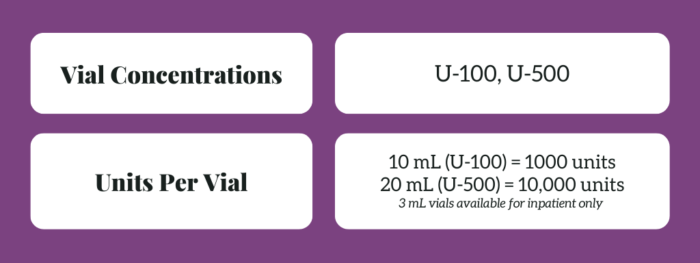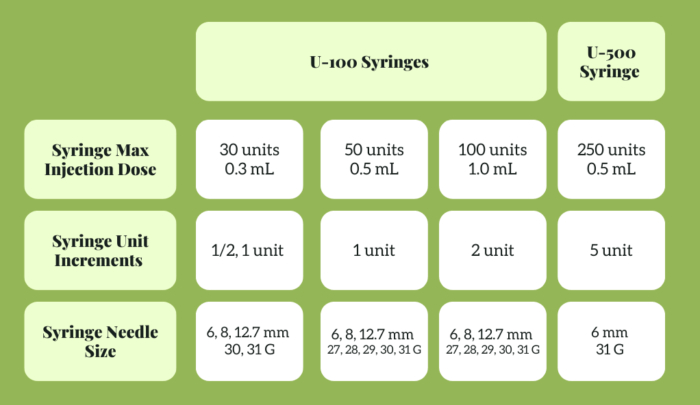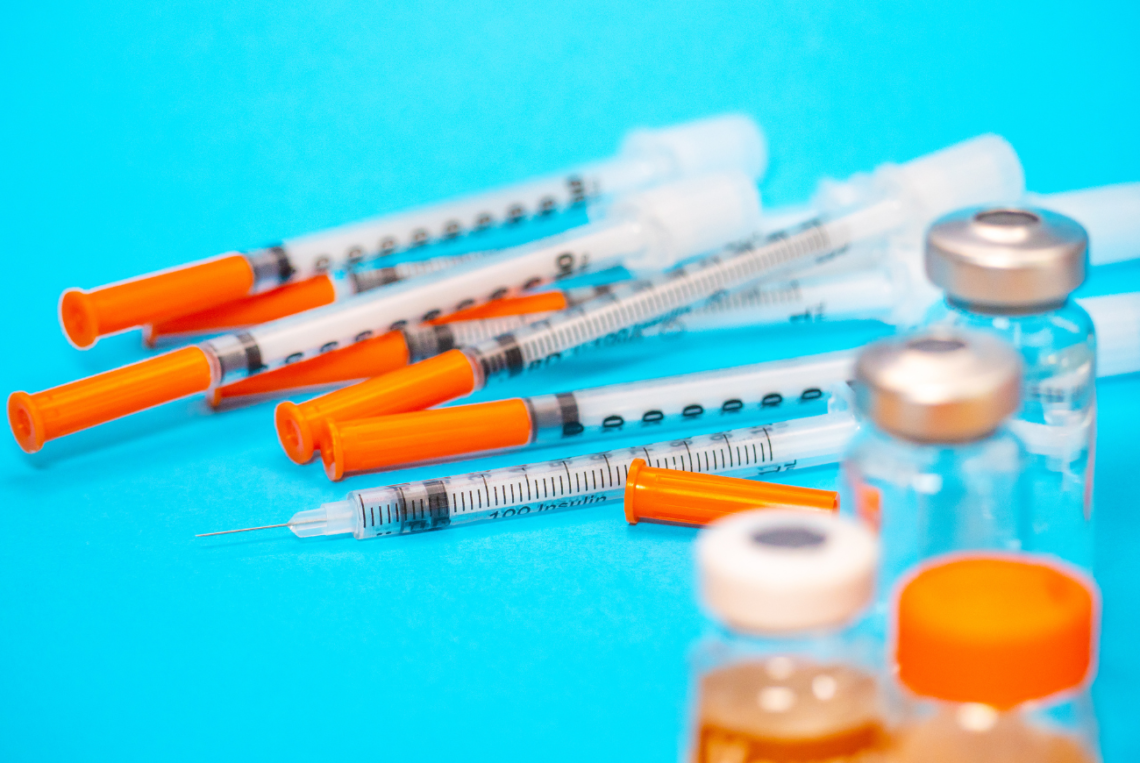
Your Guide to Diabetes Supplies: Insulin Syringes
For many people living with diabetes, insulin injections are a part of everyday life. Vials and syringes were once the only way to prescribe insulin for home use. Despite the availability of insulin pens, many people living with diabetes continue to use syringes to administer their insulin. This is due to a combination of personal preference, insurance coverage, and a lack of awareness of alternative options.
This article covers the functionality of insulin syringes, instructions for use, and tips for troubleshooting common issues with patients.
What is an Insulin Syringe?
An insulin syringe is a medical device specifically designed for administering insulin, a hormone used to regulate blood sugar levels in individuals with diabetes. An insulin syringe is used with insulin that is packaged in a vial.
Parts and Pieces of an Insulin Syringe
An insulin syringe consists of several parts and pieces, each serving a specific function. Here’s a breakdown of the components of a typical insulin syringe:
Needle: The needle is the slender, pointed part of the syringe used to deliver the insulin into the body. It is made of stainless steel and comes in various lengths and gauges (thickness). The gauge of the needle determines how thin or thick it is.
Barrel: The barrel is the cylindrical part of the syringe that holds the insulin. It is typically made of clear plastic, allowing the user to see the markings for measuring the insulin dosage accurately. The barrel is marked with units, which indicate the amount of insulin being drawn or administered.
Plunger: The plunger is a long, thin rod inside the barrel that fits snugly. It is used to draw insulin into the syringe from an insulin vial and to push the insulin out during the injection.
Plunger Tip: The plunger tip is the flat end of the plunger that is pushed by the user’s thumb or finger to control the flow of insulin in and out of the syringe.
Needle Cover: The needle of the insulin syringe comes with a protective cap or needle cover to keep it sterile and safe before use. The cap should be removed just before drawing insulin into the syringe.
Insulin Vials
An insulin vial typically consists of several parts and pieces designed to store and facilitate the administration of insulin.
The main body of the insulin vial consists of a sterile glass container that’s sealed with a rubber stopper at the top to maintain the sterility of the insulin. The rubber stopper is covered with an aluminum cap or seal. The cap needs to be removed before accessing the insulin.
Insulin vials should be stored in a cool and dark place, and the rubber stopper should be swabbed with alcohol before inserting the needle to withdraw insulin.
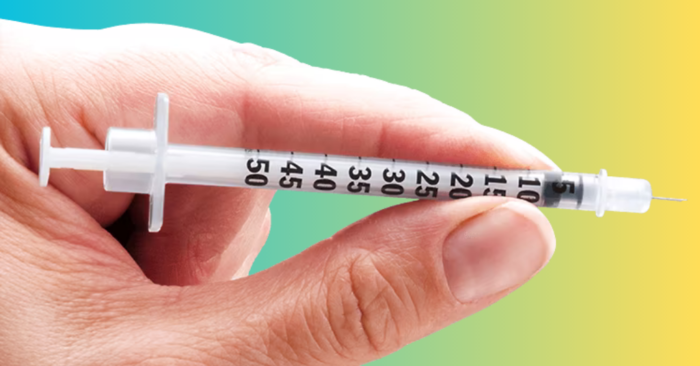
Insulin Vial & Syringe Specifications
Insulin Vial Concentrations
Insulin vials are available in two concentrations to meet the varying needs of individuals with diabetes. Additional concentrations are available in insulin pens only.
- U-100: This is the standard concentration of insulin. U-100 means that there are 100 units of insulin per milliliter (100 u/mL).
- U-500: U-500 insulin contains 500 units of insulin per milliliter (500 u/mL). U-500 insulin is typically used by individuals who have severe insulin resistance and require very high doses of insulin. It’s unique pharmacokinetics mean that dosing frequency and indications differ from U-100 insulin.
Syringe Sizes
Insulin syringes come in different size options, primarily determined by their capacity, which is measured in milliliters (mL). The most common insulin syringe sizes include:
0.3 mL: This is the smallest capacity insulin syringe available. It is used by individuals who require very small insulin doses. This syringe can dose up to 30 units.
0.5 mL: This is another smaller capacity option, suitable for those who need moderate insulin doses. This syringe can dose up to 50 units.
1.0 mL: This is the standard capacity insulin syringe and is widely used for administering insulin to a wide range of patients. This syringe can dose up to 100 units.
- U-500 syringe: This is specialized syringe designed to be used with U-500 insulin. It is available in 0.5 mL only. It is essential that individuals taking U-500 insulin in a vial use the corresponding syringe to avoid dangerous dosing errors.
Syringe Dosing Increments
The unit dosing increment of an insulin syringe refers to the smallest increment by which an insulin user can adjust the dosage in the syringe.
1/2 unit: 1/2 unit markings are available with the 0.3 mL (30 unit) syringe. This is great for children or adults on very small doses.
1 unit: Both the 0.3 mL and 0.5 mL syringes are available with 1 unit increment markings.
2 unit: 1.0 mL syringes dose in 2-unit increments. It is still possible to dose in 1-unit increments, but many find this too challenging to draw into the syringe due the small size of the barrel and markings.
5 units: U-500 insulin syringes have 5-unit increment markings. Therefore, U-500 should always be dosed and adjusted by 5 units.
Syringe Needle Lengths and Gauges
Size matters. Syringe needle length and gauge can make all the difference in comfort and absorption. Needles range from 6 mm to 12.7 mm in length. Needle thickness, called gauge, ranges from 27G to 31G. A lower gauge is associated with a thicker needle.
Shorter needles are preferred. Insulin-naive patients should start with a 6 mm syringe needle. Contrary to popular belief, body adiposity is not associated with needle length. Patients with greater body fat do not require longer syringe needles.
Longer needles are best suited for high-volume injections or for those with fibrous scare-tissue, where a deeper subcutaneous injection would help with absorption. Needle gauge increases with length—longer needles are usually thicker, allowing for improved flow and decreased injection force.
Why Use a Vial and Syringe?
Despite the ease of insulin pens, there are some advantages to using an insulin vial with a syringe.
- With a Insulin Pump. An insulin vial is used to fill the cartridge, pod, or reservoir of an insulin pump. For people that frequently go on-and-off their insulin pump, it may be easier to stick with vials, instead of filling a separate prescription for insulin pens and pen needles.
- Mixing Insulins. For people taking two or more types of insulin, they can reduce the number of injections by combining the insulin into one syringe. Note, that not all types of insulins can be mixed together.
- Reduced Cost. Vials and syringes can be more affordable than pens and pen needles, especially if your patient is paying out of pocket.
How to use an Insulin Syringe
Teaching a Patient How to Use an Insulin Syringe
This instructional video provides a comprehensive step-by-step guide on how to properly use an insulin syringe to administer insulin.
To Pinch or Not to Pinch?
Known as the skinfold technique, pinching the skin creates a “tent” of adipose tissue above the muscle to ensure the injection is administered into subcutaneous tissue. This can be helpful when using a syringe needle greater than 6mm in length, but is not necessary with shorter syringe needles.
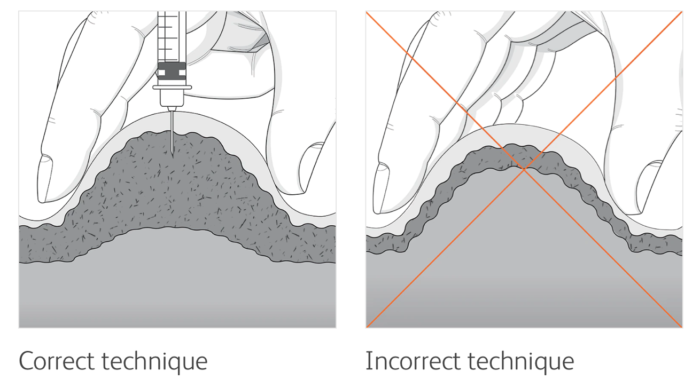
Common Issues with Insulin Syringes
While a syringe and vial is generally a reliable way to administer insulin, here are some of the more common issues individuals may encounter.
Appropriate Syringe Selection
Prescribing the appropriate syringe based on the insulin dose is important. A 1.0 mL syringe is far too large to dose 5 units of insulin. Likewise, a 0.3 mL is too small for someone taking 70 units in one dose. Dosing errors occur when there is a mismatch between the insulin dose and syringe size.
Patients on a basal-bolus regimen may need a prescription for two different syringe sizes to best accommodate their dosing.
Mixing Insulins
While taking fewer injections may sound appealing, mixing insulins can be challenging. Not all insulins can be mixed together. Air should being injected into both vials, starting first with the slower-acting insulin. When filling the syringe, the faster-acting insulin should be drawn into the syringe first, followed by the slower-acting insulin.
Be careful when drawing insulin from the second vial so as not to allow the mixture to be pushed back in. If too much insulin is drawn out or there are too many air bubbles, the user will need to start over with a new syringe. The mixture should be injected within 5 minutes.
Dexterity and Vision
As you can see from the tutorial video, holding both the vial and syringe while drawing the dose requires two steady hands and adequate reading vision. Patients with a history of stroke, peripheral neuropathy, diabetic retinopathy or vision impairments may find syringes challenging. Consider using an injection aid to assist.
Key Takeaways
- Insulin syringes are medical devices designed specifically for administering insulin. They are used with insulin vials.
- Insulin syringes vary in size, dosing increments, and needle size, including length and gauge. Be sure to select a syringe based on the patient preference and insulin injection requirements.
- Despite the availability of insulin pens, some individuals prefer using insulin vials and syringes. Other use vials and syringes out of necessity. Explore this rationale with your patient to determine if insulin pens may be more suitable.
Please reach out to me if your office or organization could use a refresher on insulin syringes, or any other diabetes supplies!


You May Also Like
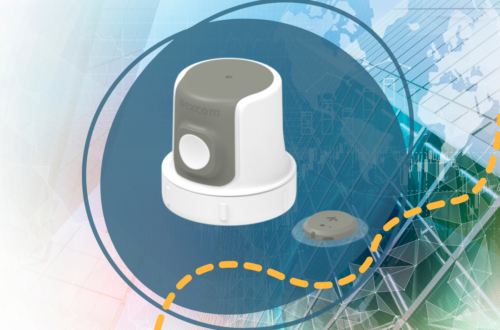
Product Review: Stelo by Dexcom
September 10, 2024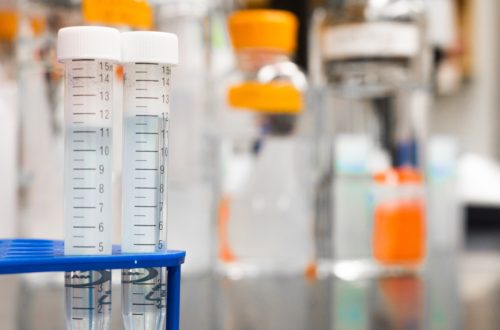
Diagnosing Type 1 Diabetes in Adults
August 10, 2022

